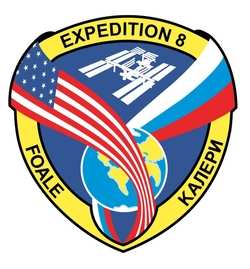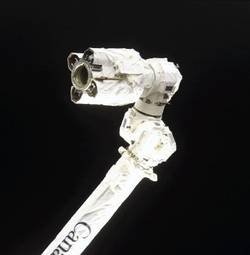Report #60, 2 p.m. CST Friday, November 21, 2003
 The eighth permanent crew to live on
the International Space Station completed its first month aboard
the complex this week, a week that saw the 16 nations that
participate in the Station program celebrate the fifth anniversary
of its launch.
The eighth permanent crew to live on
the International Space Station completed its first month aboard
the complex this week, a week that saw the 16 nations that
participate in the Station program celebrate the fifth anniversary
of its launch.
The first Station component, the control module Zarya, was
launched from the Baikonur Cosmodrome, Kazakhstan on Nov. 20, 1998.
Thirty-six launches later, the Station now has a mass of more than
412,000 pounds and a interior volume of 15,000 cubic feet, as large
as a three-bedroom house. More than 100 different space travelers
from five space agencies and nine countries have visited the
complex.
To assist planners as they evaluate a potential spacewalk early
next year, Expedition 8 Commnader Mike Foale and Flight Engineer
Alexander Kaleri spent the first part of this week working with
Russian Orlan spacesuits. They evaluated how to get into the Soyuz
spacecraft docked to the Station's Pirs compartment while wearing
the bulky suits. Such a procedure could be necessary if they were
unable to repressurize Pirs, which is used as an airlock to begin
and end Russian spacewalks, and had to board the Soyuz.
The potential February spacewalk would exchange samples in
exterior experiments and prepare an aft Station docking port for
the European Space Agency’s Automated Transport Vehicle, a
new, uncrewed station cargo vehicle targeted for launch late next
year.
 In anticipation of the crew’s
first use of the Station’s Canadarm2 robotic arm, Foale spent
time Friday going through a computer-guided refresher on arm
operations. Their first use of the arm, a training session, is
planned for early next week.
In anticipation of the crew’s
first use of the Station’s Canadarm2 robotic arm, Foale spent
time Friday going through a computer-guided refresher on arm
operations. Their first use of the arm, a training session, is
planned for early next week.
On Friday, Foale completed alterations to an instrumented suit
for use in next week’s work with the Foot/Ground Reaction
Forces During Spaceflight (FOOT) experiment. The Lower Extremity
Monitoring Suit (LEMS), a customized pair of Lycra cycling shorts
outfitted with 20 sensors, will measure forces on Foale’s
feet and joints and gauge his muscle activity while completing his
normal activities in the Station. The experiment's researchers hope
to learn more about the reasons for bone and muscle loss by
astronauts in orbit, insight that may lead to better
countermeasures for astronauts.
Engineers are analyzing the effects of a possible gyroscope
failure in the Station treadmill's vibration isolation system. The
analysis began after the crew reported hearing unusual noises from
that system. While the analysis is under way, the crew has been
asked not to use the treadmill and instead to use a stationary
bicycle and other exercise equipment.
The Expedition 7 crewmembers returned to Houston this week after
more than three weeks of medical checkups and debriefings with
Russian specialists. Commander Yuri Malenchenko and NASA ISS
Science Officer Ed Lu, who completed a 185-day spaceflight with a
landing in Kazakhstan in a Soyuz spacecraft on Oct. 27, will
continue their postflight operations with checkups and debriefings
at the Johnson Space Center.
 Aero-TV: DeltaHawks Diesel Power Steps Into the Spotlight
Aero-TV: DeltaHawks Diesel Power Steps Into the Spotlight NTSB Prelim: Mooney Aircraft Corp. M20K
NTSB Prelim: Mooney Aircraft Corp. M20K ANN FAQ: Turn On Post Notifications
ANN FAQ: Turn On Post Notifications ANN's Daily Aero-Linx (12.20.25)
ANN's Daily Aero-Linx (12.20.25) Aero-News: Quote of the Day (12.20.25)
Aero-News: Quote of the Day (12.20.25)




